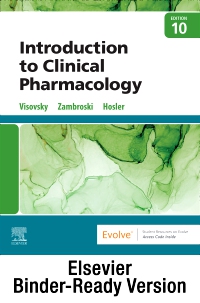
Introduction to Clinical Pharmacology - Binder Ready, 10th Edition
Binder Ready

Emphasizing safe and effective drug administration, Introduction to Clinical Pharmacology, 10th Edition, helps students understand the principles of pharmacology and prevent medication errors. It promotes safety by showing how drugs and drug classes work, so students can understand why drugs are given, as well as the adverse effects and drug interactions that may occur. A thorough nursing process section with each drug class outlines the nurse’s role when administering drugs. The updated Get Ready for the Next Generation NCLEX® Examination! feature offers case studies with Next Generation NCLEX-format questions to help students prepare for the new licensure examination.
-
- NEW! Get Ready for the Next Generation NCLEX® Examination! section includes key points, review questions, and case studies with Next Generation NCLEX-format questions to prepare students for the new licensure examination
- NEW! Reorganized chapters break up lengthy content and more logically present pharmacological content by body system or major disorder
- UPDATED! Coverage of newly approved and updated pharmaceutical treatments and drugs prepares students for practice
- Ideal scope of content and readability for LPN/LVN programs includes basic, need-to-know pharmacology content
- Safety Alert boxes highlight important nursing considerations for safe medication administration and monitoring
- Lifespan Considerations boxes for children and older adults draw attention to information that would be especially important when giving a specific drug to patients of those age groups
- A focus on understanding drug classes helps students understand the actions and uses of drug classes and provides a framework for safe, effective practice as new drugs are introduced to the market
- Video clips on medication administration procedures provide students with a visual reference for safe medication administration
- Key terms with phonetic pronunciations and text page references help improve students’ terminology and language skills before they enter clinical practice
- Essential content is highlighted throughout the text, as in all of Elsevier’s LPN Threads textbooks, with features such as Top Tips for Safety, Memory Joggers, and Lifespan Considerations boxes
-
- NEW! Get Ready for the Next Generation NCLEX® Examination! section includes key points, review questions, and case studies with Next Generation NCLEX-format questions to prepare students for the new licensure examination
- NEW! Reorganized chapters break up lengthy content and more logically present pharmacological content by body system or major disorder
- UPDATED! Coverage of newly approved and updated pharmaceutical treatments and drugs prepares students for practice
-
Unit I. General Principles
1. Pharmacology and the Nursing Process in LPN Practice
2. Legal, Regulatory, and Ethical Aspects of Drug Administration
3. Principles of Pharmacology
Unit II. Principals of Medication Administration
4. Drug Calculation: Preparing and Administering Drugs
Unit III. Drug Categories
5. Drugs for Bacterial Infections
6. Drugs for Tuberculosis, Fungal and Parasitic Infections
7. Drugs for Viral and Retroviral Infections
8. Drugs for Allergy and Respiratory Problems
9. Drugs Affecting the Renal/Urinary and Cardiovascular Systems
10. Drugs for Central Nervous System Problems
11. Drugs for Mental Health
12. Drugs for Pain Management
13. Drugs for Inflammation, Arthritis and Gout
14. Drugs for Gastrointestinal Problems
15. Drugs Affecting the Hematologic System
16. Drugs for Immunization and Immunomodulation
17. Drugs for Osteoporosis and Hormonal Problems
18. Drug Therapy for Diabetes
19. Drugs for Eye and Ear Problems
20. Over-the-Counter Drug Therapy



 as described in our
as described in our 